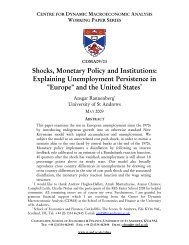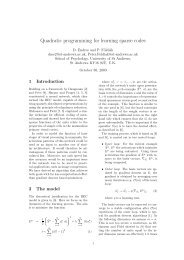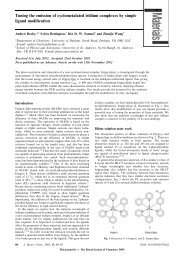Delay and Haircuts in Sovereign Debt - University of St Andrews
Delay and Haircuts in Sovereign Debt - University of St Andrews
Delay and Haircuts in Sovereign Debt - University of St Andrews
You also want an ePaper? Increase the reach of your titles
YUMPU automatically turns print PDFs into web optimized ePapers that Google loves.
value for the Optimistic debtor is<br />
<br />
<br />
( + s)<br />
<br />
+ (1 ) ~x 2 + (1 ) + <br />
:<br />
2 2<br />
2 2<br />
After a simpli…cation, we …nd that the Optimistic debtor’s cont<strong>in</strong>uation<br />
value is given by .<br />
<br />
(+s)<br />
4<br />
The cont<strong>in</strong>uation value for the Cautious debtor is <br />
t = 2, the Cautious debtor o¤ers (x 0 2 ; <br />
x0 2<br />
<br />
(+s)<br />
2<br />
s<strong>in</strong>ce, at<br />
) with a probability 1 <strong>and</strong> the<br />
creditor rejects the debtor’s o¤er <strong>of</strong> (x 0 2 ; x0 2 ) with a probability 1.<br />
F<strong>in</strong>ally, the cont<strong>in</strong>uation value for the creditor is given by<br />
<br />
q 0 x 0 2<br />
+ (1 ) ( ~x 2 ) (<br />
+ (1 q 0 )<br />
2<br />
s)<br />
<br />
;<br />
where the …rst term refers to the creditor’s payo¤ if the debtor is Optimistic<br />
<strong>and</strong> the second term refers to the creditor’s payo¤ if the debtor is Cautious.<br />
After a simpli…cation <strong>and</strong> a substitution <strong>of</strong> the term ~x 2 , we obta<strong>in</strong>:<br />
(<br />
<br />
2<br />
s)<br />
<br />
1<br />
s<br />
<br />
(1 q 0 ) +<br />
s<br />
Scenario 2: The debtor does not know her own type<br />
s<br />
s<br />
<br />
(1 q 0 ) x 0 2 :<br />
Under this scenario, the creditor’s cont<strong>in</strong>uation value is the same as <strong>in</strong><br />
Scenario 1, but the debtor’s cont<strong>in</strong>uation payo¤ is<br />
<br />
<br />
q 0 x 0 2 + (1 ) ~x 2 + <br />
+ (1 q 0 ) <br />
2<br />
2<br />
which after substitution <strong>and</strong> simpli…cation becomes<br />
2 ( + s)<br />
2<br />
2<br />
<br />
q0<br />
:<br />
2<br />
( + s)<br />
2<br />
<br />
;<br />
In the …rst period, the sovereign debtor is a proposer. It follows from the<br />
two scenarios we considered above that the expected payo¤ for the creditor<br />
from reject<strong>in</strong>g the debtor’s o¤er at t = 1, ^a, is given by<br />
0 h<br />
p q 0 ( ( L x 0 2<br />
^a = @<br />
) + (1 ) ( L ~x 2 )) + (1 q 0 )<br />
h<br />
+ (1 p) q 0 ( ( H x 0 2 ) + (1 ) ( H ~x 2 )) + (1 q 0 )<br />
i<br />
<br />
(L s)<br />
2<br />
(H<br />
2<br />
s)<br />
i<br />
1<br />
A :<br />
32
















